| DongFeng 5 (CSS-4) Intercontinental Ballistic Missile
中国DF-5(CSS-4)洲际弹道导弹 Date:2013-10-26 Source:internet By:globalmil Viewed: |
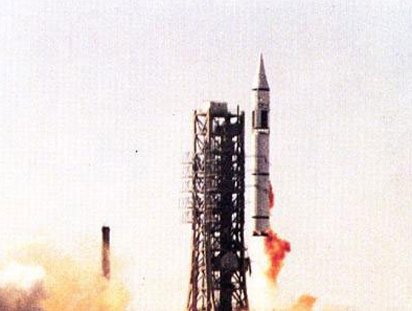
The DF-5 is China's first operational ICBM.DF-5是中国第一种操作的ICBM
The Dong Feng-5 (DF-5, NATO codename: CSS-4) is China’s first intercontinental ballistic missile (ICBM). Developed by China Academy of Launch Vehicle (CALT, also known as 1st Aerospace Academy), it is a silo-based, two-stage, liquid propellant ballistic missile. The missile carries a single 3 megatons nuclear warhead and has an effective range of 12,000km. The DF-5A is the improved variant with an extended range. The PLA currently deploys approximately 24~36 of this missile deployed in central China.
中国“东风”(Dong Feng)-5(DF-5,北约代号:CSS-4)是中国第一种洲际弹道导弹(ICBM)。由中国运载火箭研究院(CALT,也即是第一航空宇宙学院)发展,它是一种发射井-基,二级、液体推进剂弹道导弹。导弹携带一枚单一的3百万吨核弹头,有效射程12,000公里。DF-5A是增加射程改进型。PLA目前大约部署这种型号导弹约24~36枚。
PROGRAMME
Following the success of the DF-4 (CSS-3) long-range ballistic missile, in 1964 China began to develop its first true ICBM capable of reaching the United States. The same design was also later used to develop China’s Chang Zheng (Long March) family space launch vehicle and became the foundation of the Chinese space programme.
计划
在DF-4(CSS-3)远程弹道导弹成功之后,1964年中国开始发展能够到达美国的第一种真正的洲际弹道导弹(ICBM)。相同的设计稍后也用于发展中国长征(Chang Zheng)系列空间运载火箭而且变成中国空间计划的基础。
In the whole 1970s, the Chinese space activities were slowed down to prepare for the experimental fire tests of the DF-5 ICBM. However throughout the 1970s, the DF-5 became, amongst a lot of other defence projects, a casualty of the political chaos spawned from the Cultural Revolution. The first test launch of the DF-5 took place in September 1971 at Jiuquan (Shuang Cheng Zi). After the slow start, intense development began in the late 1970s with five extensive live tests in 1979 alone (7 January, 15 July, 21 August, 4 September, and possibly another one in October). The final test shot was fired in February 1980.
在整个1970年,中国空间活动减慢准备进行DF-5 ICBM实验发射测试。然而在1970年自始至终,DF-5结果由于某些原因没有进行。在开始减缓之后,迅速发展在1970年后期开始。DF-5的第一次试射1971年9月在酒泉(Shuang Cheng Zi)进行。在1979年进行了五次实弹测试(1月7日、7月15日、8月21日、9月4日和可能另外一次在10月)。最后测试发射在1980年2月。
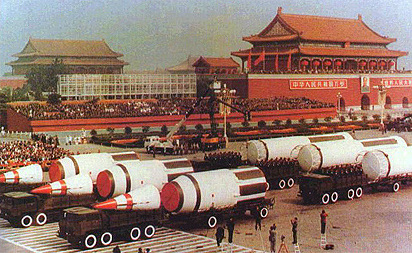
The DF-5 ICBM was demonstrated in the 1984 military parade to celebrate the 35th anniversary of the People's Republic of China.DF-5 ICBM在1984年庆祝中华人民共和国成立第35周年阅兵式上展示
By 1980 China had overcome the slowdown in nuclear development caused by the Cultural Revolution and had some spectacular successes in its strategic weapons programme. Preparation for full-range tests base exercises at the Shuang Cheng Zi site and ship exercises in the Yellow Sea began in March 1980. Finally, on 18 and 21 May, two long-range shots were made into the Pacific Ocean, where it was recovered by a PLA naval task force. The first missile travelled approximately 9,500 km from the launch site to an area bounded by the Gilbert Islands, the Solomons, Fiji, and the New Hebrides, with splash-down occurring at 02:30 Greenwich mean time, while details of the second fire remain unknown.
到1980时中国已经克服国内问题所引起的核发展减缓而且它的战略武器计划有一些惊人成就。在1980年3月开始准备,在酒泉进行全程测试练习,辅助的舰艇在黄海练习。最后,在5月18日和21日,两枚远程发射成功进入太平洋,被PLA海军特遣部队顺利回收。第一枚导弹从发射位置到一个限制区域,范围在吉柏特岛、所罗门群岛、斐济和新赫布里底群岛,大约飞行9,500公里, 在格林威治时间02:30落下,第二枚发射细节未知。
OPERATIONAL STATUS
The DF-5 entered operational service in 1981, and were deployed in hardened constructions in central China. Initially the DF-5 was deployed in a similar style as the DF-4 long-range ballistic missile. The missile was stored in a horizontal position in tunnels under high mountains, and are launched immediately outside the mouth of the tunnel. The fuelling operation of the missile normally requires two hours.
操作状态
DF-5在1981年进入了操作服役, 而且在中国中部建造的核防护设施中部署。最初DF-5采用一种相似的风格被部署,如DF-4远程弹道导弹。导弹被储存在高山下面的隧道一个水平位置中,而且移到隧道口外面立刻发射。导弹加注燃料操作正常需要二个小时。
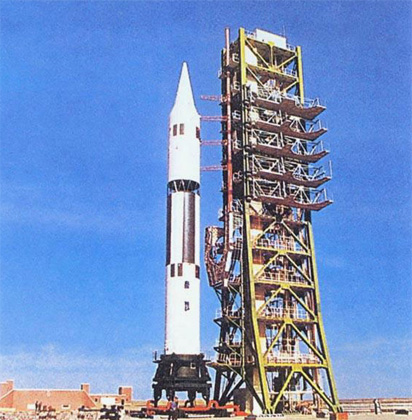
The DF-5 ICBM on the launch pad.在发射台上的DF-5 ICBM
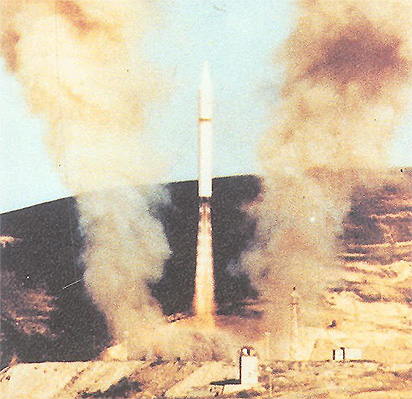
The improved DF-5 is launched from hardened silo.改进型DF-5A从硬化发射井中发射
Later production variants of the DF-5 and improved DF-5A are probably deployed in silos and maintained in a ready-to-fire status. In order to enhance the survivability of these missiles, the PLA has constructed a large number of decoy silos which consist of shallow holes excavations with headworks that resemble operational silos. Sophisticated engineering and the introduction of the computerised launch control systems have greatly decreased the launch preparation time of these missiles.
稍后生产型DF-5和改良型DF-5A或许在发射井部署并且保持在就绪-到-发射状态。为了要提高这些导弹的生存性,PLA已经大量建造很多诱骗发射井,包括浅挖掘井(不可部署导弹)和准备性的类似的操作发射井(可部署导弹)。复杂的工程技术和引进计算机发射控制系统已经非常减少这些导弹的发射准备时间。
The exact number of the missile in service remains highly classified, and observer estimations vary significantly, ranging from less than 10 to over 30. According to some reports, by 2000 the DF-5 forces of the PLA Second Artillery Corps consisted of three brigades.
真正的运行中的导弹数目保持高度机密,观察者判断变化较大,范围从小于10枚到超过30枚。依照一些报道,PLA第二火炮部队的DF-5部队,由三个旅组成,人数约2000人。
The first, the 803rd brigade, was established in October 1984, the 35th anniversary of the founding of the People’s Republic of China (PRC). Presently, this brigade is located near Huaihua, within the deep mountains of Hunan province, around 750km north-west of Guangzhou. The 803rd is considered an excellent model of the service, never missing its targets in any exercise. This brigade was equipped entirely with improved DF-5A ICBMs and related equipment by the mid-1990s.
第一个,第803旅,在1984年10月建立,也就是中华人民共和国成立第35周年。目前,这个旅位于怀化(Huaihua)附近,在湖南(Hunan)省的深山里,大约距广州750公里西北方。第803旅被考虑是服役的一个极好的典型,在练习中从没有丢失任何目标。这个部队在1990年中期,完全地装备改进型DF-5A ICBM和相关设备。
The second brigade is the 804th brigade and was organised at the end of the 1980s. It is located inside a mountain range in the western part of Henan province, not far from Luoyang City (around 700km southwest of Beijing). Early 1995, China's media reported that the “Great Wall Project ” for China's strategic missile force was finally completed after ten years of construction in the Tai-Hang Mountain Range between Hebei and Shanxi provinces. According to the news reports, "tens of thousands" of Army engineers spent over 10 years there digging tunnels. According to some reports, this facility enables DF-4 and DF-5 missiles to be stored and mobilised through underground tunnels to increase their survivability. The 804th brigade is most likely to be associated to this facility considering its location.
第二个,第804旅,在1980年结束的时候建立。它位于河南省西部的太行山内, 离洛阳(Luoyang)市不很远(在北京西南大约700公里)。早在1995年,中国的媒体报道用于中国战略导弹的“长城计划”,最后在10年之后完成,在河北省和山西省之间的太行山内。依照新闻报道,“好几万”军队工程人员花费10年开挖隧道。 依照一些报道,这些设施允许DF-4和DF-5导弹能够被储存并且机动穿越地下隧道增加他们的生存性。第804旅考虑它的位置有可能在这些设施内部署。
The third unit, known as the 818th brigade, was established in 1996 and is subordinated to Hunan province, like the 803rd. Formation of the 818th was said to have completed in 1999.
第三个,即是第818旅,在1996年在湖南省建立。第818旅的组建据称已经在1999年完成。
Each brigade operates about 8~12 missiles. By the year 2000, all three brigades had been equipped with improved DF-5A ICBMs.
每个旅大约操作8~12枚导弹。2000年以前,所有的三个旅已经被装备改进型DF-5A ICBM。
WARHEAD
The DF-5 carries a single 3 megatons nuclear warhead. Multiple independently targetable re-entry vehicle (MIRV) warhead capability was in mind when the DF-5 was developed as with the CZ-2C commercial rocket, a twin of the DF-5 that has the ability to launch four satellites in a single load. Although the DF-5 can be modified for MIRV capability, none is known be have done so. This is very likely a policy decision not to upset the strategic balance of power. But even with the deployment of US TMD/NMD imminent, MIRV conversion of the DF-5 seems unlikely. Such necessity rests upon the new generation of ICBMs such as DF-31.
弹头
DF-5携带一枚单一的3百万吨核弹头。多目标分导重返大气层运载装置(MIRV)能力在注意中,DF-5被发展如同孪生商业型CZ-2C商业火箭一样,CZ-2C有能力发射一次集中负载四颗卫星。虽然DF-5用于MIRV能力能够被修改,但是据知没有这样做。这很有可能一个政策决定,不去颠覆战略力量天平。但是由于美国急切部署TMD/NMD,DF-5的MIRV转换不太可能。在ICBM,必须取决于新一代之上,像是DF-31。
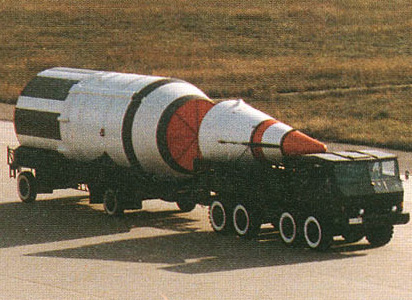
The second stage of the DF-5 ICBM.DF-5 ICBM的第二级
The DF-5 is equipped with four veneer rocket motors for steering and sustaining propulsion for a further 190 seconds after the shutting of the main motor, and enabling a wide aiming arc for the re-entry vehicles in the upper atmosphere. A further development of the DF-5 is the DF-5A, with a range augmentation to over 13,000 km and an improved inertial guidance system.
DF-5安装使用4台单极发动机用于操纵和在脱离主发动机后进一步持续推进190秒,启动再返回载体在大气层上瞄准目标距离控制。DF-5进一步发展是DF-5A,具有超过13,000公里的增大射程和一个改进惯性制导系统。
PROPELLANT
The first stage of the DF-5 utilises a YF-6 rocket motor, which consists of four 75-ton thrust YF-20 chambers motors (with swinging nozzles) burning N2O4/UDMH. The second stage utilises a YF-24 rocket motor consisting of one 75-ton thrust YF-22 motor (with fixed nozzles) and a YF-23F swivelling venire motor with four 4.8-ton thrust chambers burning N2O4/UDMH. The missile has an effective range of 12,000km and delivers a payload of 3,000kg. The improved DF-5 has an effective range of 13,000km.
推进剂
DF-5的第一个级采用一台YF-6火箭发动机,由四台75吨推力YF-20钱伯斯发动机(采用摇摆喷嘴)所组成,燃烧 N2O4/UDMH推进剂。第二级采用一台YF-24火箭发动机由一台75吨推力YF-22发动机(采用固定喷嘴)和四台4.8吨推力的YF-23F发动机所组成,燃烧N2O4/UDMH推进剂。导弹有效射程12,000公里并且递送3,000公斤的一个负载,改进的DF-5A有效射程13,000公里。
Early variant of the DF-5 required up to two hours in fuelling time prior to launch, but this might have been reduced on the improved DF-5A.
早期型DF-5在发射之前必须耗费2个小时加注燃料,但是这可能已经在改进型DF-5A上被减少。
SPECIFICATIONS
Configuration: Two stage liquid
Length: 33m
Diameter: 3.4m
Launch Weight: 183,000kg
Propellant: Liquid fuel (Unsymmetrical Dimethylhydrazine/Nitrogen Tetroxide mix [UDMH/N2H4])
Guidance: Inertial with onboard computer
Range: 12,000km (DF-5); >13,000km (DF-5A)
Deployment: Silo and launch pad
Re-entry Vehicle Mass: ~3,000kg
Warhead: Single 3,000~5,000kT
CEP: ~1,000m
Launch Preparation Time: 120 min (mobile), or 45~60 min (in silo)
规格
组态: 二级液体推进剂
长度: 33 m
直径: 3.4 m
发射重量: 183,000 kg
推进剂: 液体燃料(非对称二甲基胼(Dimethylhydrazine)/氮四氧化物(Nitrogen Tetroxide)混合[UDMH/N2H4])
制导: 惯性采用弹载计算机
射程: 12,000 公里(DF-5);>13,000 公里(DF-5 A)
部署: 发射井和发射台
再返回运载工具质量: ~3,000 kg
弹头: 单一 3,000~5,000 kT
圆概率误差(CEP): ~1,000 m
发射准备时间: 120 分钟,或45~60 分钟(在发射井中)
Date Last Updated: 2 April 05
最后更新: 2005年4月2日
上一篇:DongFeng 4 (CSS-3) Intermediate-Range Ballistic Missile 下一篇:DongFeng 21 (CSS-5) Medium-Range Ballistic Missile
| DF-1 ballistic missile system
中国东风-1(DF-1)弹道导弹系统 |
| China’s first ballistic missile system, a licensed copy of the Soviet R-2 (SS-2 ‘Sibling’) short-range ballistic missile.... [2020-04-05] |
| B611 TACTICAL SURFACE-TO-SURFACE BALLISTIC MISSILE
中国B611战术地对地弹道导弹 |
| The B611 is the solid-fuel, surface-to-surface, short-range ballistic missile (SRBM) jointly developed by China Aerospace Science & Industry Corporation (CASIC) and Turkish weapon manufacturer MKEK.... [2017-01-15] |
| DF-21/A/C(CSS-5 Mod1/2/3)medium-range ballistic missile
中国东风-21/A/C型中程弹道导弹 |
| The DF-21 is a two-stage, solid-fuel rocket, single-warhead medium-range ballistic missile (MRBM) in the Dong Feng series developed by China Changfeng Mechanics and Electronics Technology Academy.... [2016-08-17] |
| DongFeng 31A (CSS-9 Mod-2) Intercontinental Ballistic Missil
中国DF-31A(CSS-9 Mod-2)洲际弹道导弹 |
| The DongFeng 31A (NATO reporting name: CSS-9 Mod-2) is a road-mobile, three-stage, solid-propellant intercontinental ballistic missile (ICBM), designed to carry a single 1,000kT thermal nuclear warhead.... [2016-01-04] |
